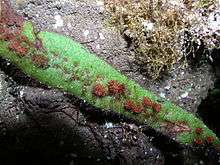Grammitidoideae
Grammitidoideae is a subfamily of the fern family Polypodiaceae, whose members are informally known as grammitids. It comprises a clade of about 750 species.[1] They are distributed over higher elevations in both the Old and New World.[2] This group was previously treated as a separate family, Grammitidaceae until molecular phylogenies showed it to be nested within the Polypodiaceae. It has since been treated as an unranked clade within subfamily Polypodioideae (renamed tribe Polypodieae in one classification), and, most recently, as a separate subfamily (reducing Polypodioideae to an evolutionary grade).
| Grammitidoideae | |
|---|---|
 | |
| Grammitis hookeri | |
| Scientific classification | |
| Kingdom: | Plantae |
| Clade: | Tracheophytes |
| Class: | Polypodiopsida |
| Order: | Polypodiales |
| Suborder: | Polypodiineae |
| Family: | Polypodiaceae |
| Subfamily: | Grammitidoideae Parris & Sundue |
| Genera | |
|
See text | |
Circumscription
In 2011, Christenhusz et al.[3] placed the grammitid ferns in the subfamily Polypodioideae, within the Polypodiaceae, as an informal group without rank. In 2014, Christenhusz and Chase expanded the circumscription of both family and subfamily, placing the Polypodioideae as previously delimited, including grammitids, in tribe Polypodieae. The PPG I classification of 2016 largely reverted to the 2011 circumscriptions of these groups, but placed the grammitids in a new subfamily.
The following phylogram shows a likely relationship between grammitid ferns and the Polypodiaceae subfamilies, based on Schuettpelz & Pryer, 2008,[4] with PPG I subfamilies shown.[5]
| Polypodiaceae |
| ||||||||||||||||||||||||||||||
Genera
The Pteridophyte Phylogeny Group classification of 2016 (PPG I) recognizes the following genera:[5]
- Acrosorus Copel. – Southeastern Asia
- Adenophorus Gaudich. – Hawaii)
- Alansmia M.Kessler, Moguel, Sundue & Labiak – Neotropics, Africa
- Archigrammitis Parris – Malesia, Polynesia
- Ascogrammitis Sundue – Neotropics
- Calymmodon C.Presl – Southeastern Asia
- Ceradenia L.E.Bishop – mainly tropical Africa
- Chrysogrammitis Parris – Southeastern Asia
- Cochlidium Kaulf. (including Xiphopteris Kaulf.) – Neotropics, Taiwan
- Ctenopterella Parris – Southeastern Asia, Australia
- Dasygrammitis Parris – Southeastern Asia
- Enterosora Baker – Neotropics, Madagascar
- Galactodenia Sundue & Labiak – Neotropics
- Grammitis Sw. – Neotropics
- Lellingeria A.R.Sm. & R.C.Moran – Neotropics
- Leucotrichum Labiak – Neotropics, Madagascar
- Lomaphlebia J.Sm.
- Luisma M.T.Murillo & A.R.Sm. – Colombia
- Melpomene A.R.Sm. & R.C.Moran – Neotropics
- Micropolypodium Hayata – China, Japan
- Moranopteris R.Y.Hirai & J.Prado – Neotropics
- Mycopteris Sundue – Neotropics
- Notogrammitis Parris – Australia, New Zealand
- Oreogrammitis Copeland – Southeastern Asia, Australia
- Prosaptia C.Presl (including Ctenopteris Blume ex Kunze) – Southeastern Asia
- Radiogrammitis Parris – Southeastern Asia, Pacific islands
- Scleroglossum Alderwerelt (including Nematopteris Alderw.) – Southeastern Asia, Pacific islands
- Stenogrammitis Labiak – Neotropics, Africa, Pacific islands
- Terpsichore A.R.Sm. – Neotropics
- Themelium (T.Moore) Parris – China, Philippines, Thailand
- Tomophyllum (E.Fournier) Parris – China, Inda, Nepal
- Xiphopterella Parris – China
- Zygophlebia L.E.Bishop – Neotropics, Madagascar; sunk into Enterosora in 2019
References
- "Systematics of grammitid ferns: Lellingeria, Melpomene, and Terpsichore". Botanical Society of America. Retrieved 23 August 2011.
- Labiak et al. 2010a Paulo H. Labiak, Michael Sundue, & Germinal Rouhan: "Molecular Phylogeny, Character Evolution, and Biogeography of the Grammitid Fern Genus Lellingeria (Polypodiaceae)." American Journal of Botany 97(8): 1354–1364 (2010)
- Maarten J. M. Christenhusz, Xian-Chun Zhang & Harald Schneider (2011). "A linear sequence of extant families and genera of lycophytes and ferns" (PDF). Phytotaxa. 19: 7–54. doi:10.11646/phytotaxa.19.1.2.
- Eric Schuettpelz & Kathleen M. Pryer (2008). "Chapter 15: Fern phylogeny" (PDF). In Tom A. Ranker & Christopher H. Haufler (ed.). Biology and Evolution of Ferns and Lycophytes. Cambridge University Press. pp. 395–416.
- PPG I (2016). "A community-derived classification for extant lycophytes and ferns". Journal of Systematics and Evolution. 54 (6): 563–603. doi:10.1111/jse.12229.